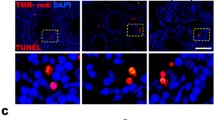Summary
The present study was aimed at finding an effective method to isolate and purify the subtype of type A spermatogonial stem cells (SSCs) in juvenile rats. Testes from 9-days-old rats were used to isolate germ cells by using two-step enzymatic digestion. The expression of c-kit in the testes of the rats was immunohistochemically detected. After isolation, cell suspension was enriched further by discontinuous density gradient centrifugation. Then type A1–A4 spermatogonia was isolated from the purified spermatogonia with c-kit as the marker by using fluorescence-activated cell sorting (FACS). Electron microscopy was used to observe their ultrastructure. Finally, highly purified and viable subtype of SSCs was obtained. Cells separation with discontinuous density gradient centrifugation significantly increased the concentration of c-kit positive cells [(18.65±1.69)% after the centrifugation versus (3.16±0.84)% before the centrifugation, P<0.01]. Furthermore, the recovery and viability were also high [(65.9±1.24)% and (85.6±1.14)%]. It is concluded that FACS with c-kit as the marker in combination with discontinuous density gradient centrifugation can well enrich type A1–A4 spermatogonia from the testes of 9-days-old rats.
Similar content being viewed by others
References
Huckins C. The spermatogonial stem cell population in adult rats. II. A radioautographic analysis of their cell cycle properties. Cell Tissue Kinet, 1971,4(4):313–334
Clermont Y, Mauger A. Existence of a spermatogonial chalone in the rat testis. Cell Tissue Kinet, 1974,7(2):165–172
Dettin L, Ravindranath N, Hofmann M C et al. Morphological characterization of the spermatogonial subtypes in the neonatal mouse testis. Biol Reprod, 2003,69(5):1565–1571
Huckins C, Oakberg E F. Morphological and quantitative analysis of spermatogonia in mouse testes using whole mounted seminiferous tubules, I. The normal testes. Anat Rec, 1978,192(4):519–528
Lacham-Kaplan O. In vivo and in vitro differentiation of male germ cells in the mouse. Reproduction, 2004,128(2):147–152
Malkov M, Fisher Y, Don J. Developmental schedule of the postnatal rat testis determined by flow cytometry. Biol Reprod, 1998,59(1):84–92
van Pelt A M, Morena A R, van Dissel-Emiliani F M et al. Isolation of the synchronized A spermatogonia from adult vitamin A-deficient rat testes. Biol Reprod, 1996,55(2):439–444
Rossi P, Dolci S, Sette C et al. Molecular mechanisms utilized by alternative c-kit gene products in the control of spermatogonial proliferation and sperm-mediated egg activation. Andrologia, 2003,35(1):71–78
Dolci S, Williams D E, Ernst M K et al. Requirement for mast cell growth factor for primordial germ cell survival in culture. Nature, 1991,352(6338):809–811
Godin I, Deed R, Cooke J et al. Effects of the steel gene product on mouse primordial germ cells in culture. Nature, 1991,352(6338):807–809
Broudy V C. Stem cell factor and hematopoiesis. Blood, 1997,90(4):1345–1364
Besmer P, Manova K, Duttlinger R et al. The kit-ligand (steel factor) and its receptor c-kit/W: pleiotropic roles in gametogenesis and melanogenesis. Dev Suppl, 1993: 125–137
Packer A I, Besmer P, Bachvarova R F. Kit ligand mediates survival of type A spermatogonia and dividing spermatocytes in postnatal mouse testes. Mol Reprod Dev, 1995,42(3):303–310
Kissel H, Timokhina I, Hardy M P et al. Point mutation in kit receptor tyrosine kinase reveals essential roles for kit signaling in spermatogenesis and oogenesis without affecting other kit responses. EMBO J, 2000,19(6):1312–1326
Author information
Authors and Affiliations
Additional information
Yang BAI, male, born in 1980, M.D., Ph.D.
This project was supported by a grant from the National Natural Sciences Foundation of China (No. 30371424).
Rights and permissions
About this article
Cite this article
Bai, Y., Ye, Z. & Zeng, F. Isolation of subtype spermatogonia in juvenile rats. J. Huazhong Univ. Sci. Technol. [Med. Sci.] 28, 435–438 (2008). https://doi.org/10.1007/s11596-008-0413-1
Received:
Published:
Issue Date:
DOI: https://doi.org/10.1007/s11596-008-0413-1




